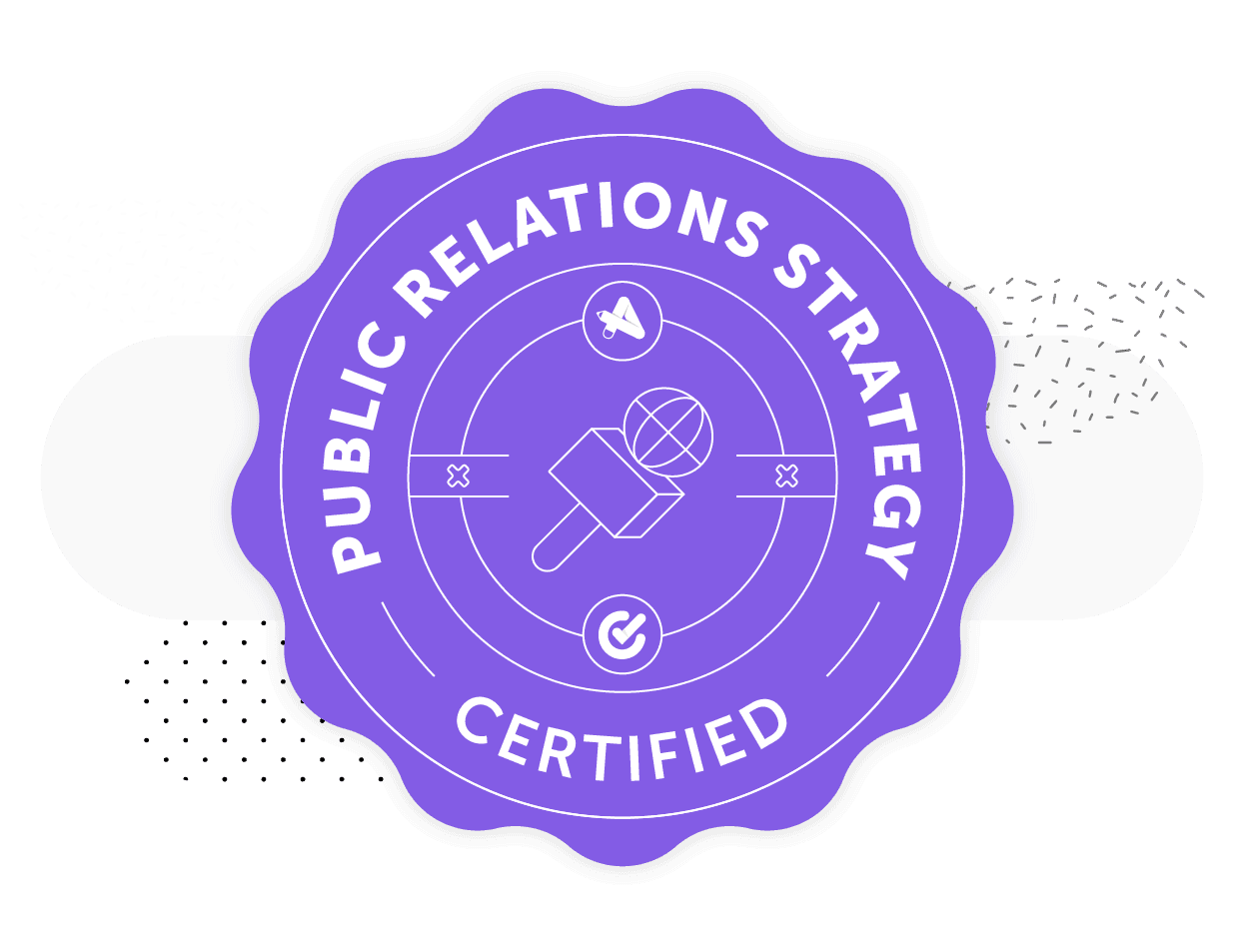How to Write Customer Success Stories That Sell (Template)
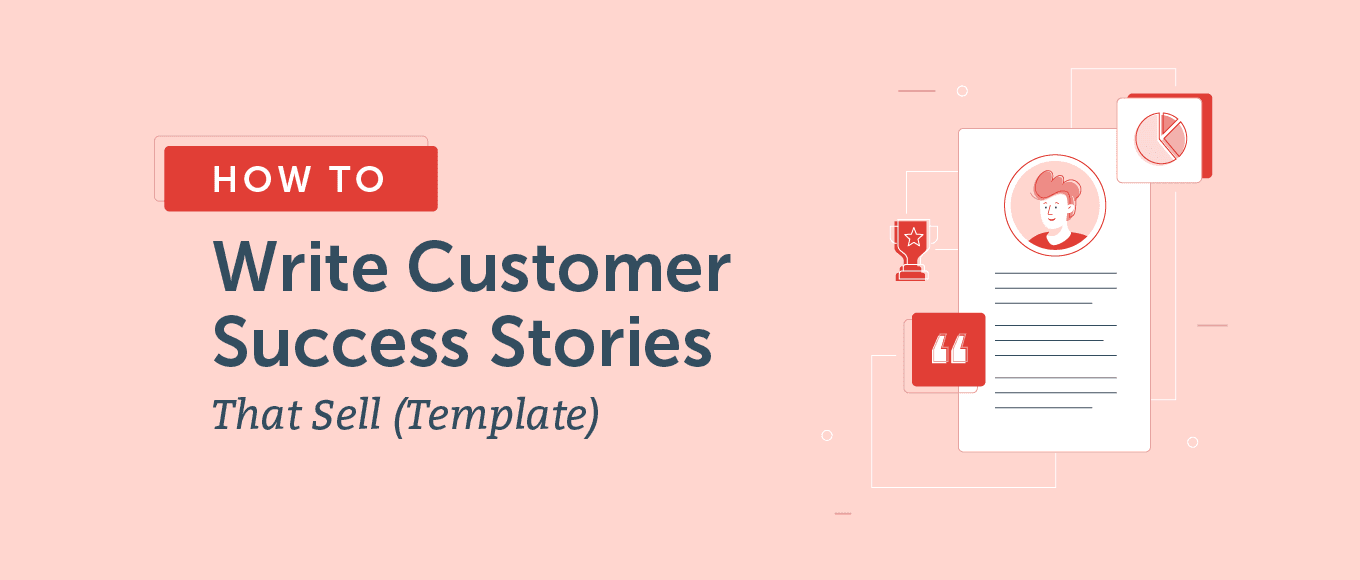 In an ideal world, your target customers would see the same thing you do: they need your product to solve their pain point.
But here’s the thing: getting there takes a while. A few years ago, we learned that 47% of B2B buyers consume three to five pieces of content before they engage with a salesperson. That’s good news for focused marketing teams — if you know what to focus on.
In other words: if you’re already regularly creating content, is it working on simply attracting traffic, or is it also helping you convert it? To make conversions happen, you need to show what it’s like to solve a pain point by working with you.
Enter: customer success stories.
They’ll supercharge your conversions and sales, but you need to be strategic about them. In this guide, you’ll learn:
In an ideal world, your target customers would see the same thing you do: they need your product to solve their pain point.
But here’s the thing: getting there takes a while. A few years ago, we learned that 47% of B2B buyers consume three to five pieces of content before they engage with a salesperson. That’s good news for focused marketing teams — if you know what to focus on.
In other words: if you’re already regularly creating content, is it working on simply attracting traffic, or is it also helping you convert it? To make conversions happen, you need to show what it’s like to solve a pain point by working with you.
Enter: customer success stories.
They’ll supercharge your conversions and sales, but you need to be strategic about them. In this guide, you’ll learn:
- How to find the best customers to feature so that your customer stories have maximum impact
- The exact questions to ask your customers, as well as how to reach out to them
- The best practices to write, publish, and repurpose each customer success story
How to Write Customer Success Stories That Sell (Template)
Click To Tweet- What is a Customer Success Story?
- Why Should You Create Customer Success Stories?
- Ideal Customers For Great Stories of Success
- Reaching Out to Customers For Customer Success Stories
- 20 Questions For Your Customer Success Story Interview
- Turning Interview Into Website Content
- 5 Ideas to Share and Repurpose Your Customer Success Stories
- Customer Success Story Checklist
Public Relations Certification: Customer Stories, Case Studies, Press Releases, & More
Are you ready to become a Public Relations Pro? The first step is getting PR Strategy certified with Actionable Marketing Institute. This course is filled with video tutorials, templates and other great content to help you create a successful PR strategy. A strong public relations strategy can allow your brand to reach new audiences, improve brand credibility, and create growth based partnerships.
Interested in learning more? Get all the details here.
A strong public relations strategy can allow your brand to reach new audiences, improve brand credibility, and create growth based partnerships.
Interested in learning more? Get all the details here.
What is a Customer Success Story?
A customer success story paints a vivid picture of the benefits of working with your company.Why Should You Create Customer Success Stories?
Wondering if customer success stories are right for your industry or company size? The answer is always yes. Check out these benefits of customer success stories to learn why.Help Your Prospect Visualize the Solution
Listing your product’s features is good. Listing the benefits that come from those features is better.Listing your product's features is good. Listing the benefits that come from those features is better.
Click To TweetEmpower Your Sales and Marketing Teams
The more customer success stories you build, the more powerful tool they become for your prospect-facing teams. The reason? You can write success stories about the types of customers you want to attract more. For example, CoSchedule can be used by in-house marketing teams of different sizes, as well as by marketing agencies. CoSchedule’s customer stories reflect that, and they make it easy to nurture many types of potential customers.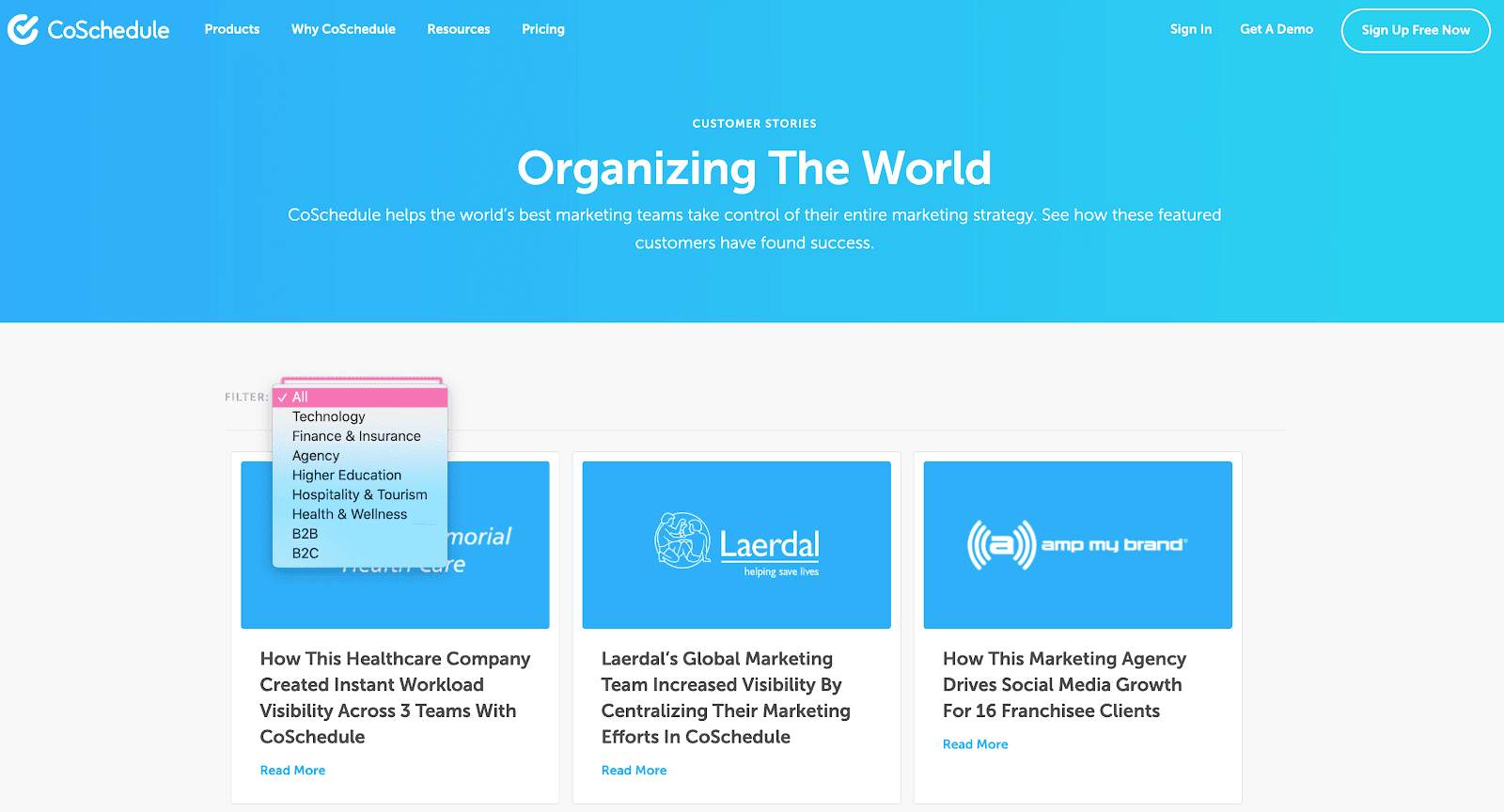 This benefit ripples out even further, because customer success stories can become:
This benefit ripples out even further, because customer success stories can become:
- Evergreen resources that attract relevant traffic from search engines
- Reusable content across different formats and platforms
- An asset for your prospect to get other stakeholders on board
Your Customer Stories Become Your Company Stories
Many companies try to craft a clever, creative, unique statement of company’s purpose. As a result, it often ends up sounding vague, generic, and anything but unique. In her Harvard Business Review essay, writer and consultant Erica Keswin shared the way around this: highlighting specific stories from customers. Here’s why:“Stories are free, always available, and are such a core part of our human DNA that they automatically make us feel good. Especially when they’re true. And best of all, when a company brings true stories to light, the culture becomes one of paying attention. Leaders and managers learn to keep their eyes and ears on what’s most important — the real experiences of real people.”She continues by sharing examples of companies like Lyft and JetBlue, who have made customer stories the core of their communications, both internally and externally. Erica wraps up with a reminder to “start paying attention to the stories unfolding in your organization, and figure out how to help the best ones spread. Because people have a lot to say, and if we’re smart, we’ll start listening.”
Find Your Ideal Customers For Great Stories of Success
How can you identify customers that would make the best success stories? Here are two main strategies you can use.Follow the Indicators of Happy Customers
There are some universal happy customer traits. For example, these customers:- Have been your customer for a long time
- Spend more money with you than most of your customers
- Buy from you frequently
- Refer others to you
- Are easy to support from a customer service perspective
Look For Power Users
To take it to the next level, look for customers that use your product frequently and regularly. Of all your customers, they’re the ones most likely to experience measurable results that wouldn’t have happened otherwise.- Ecommerce reports
- Customer service tool (notes, chat logs, call transcripts, emails, etc.)
- Loyalty program software
- Project management system (especially if you sell services rather than products)
How to Reach Out to Customers For Your Customer Success Story
You have a list of potential customers to feature as success stories. Your next step is to reach out to them.You have a list of potential customers to feature as success stories. Your next step is to reach out to them.
Click To Tweet- You’ve already verified that these customers are successful thanks to you — they’ll be happy to hear from you!
- By featuring them as a success story, you’ll give them more visibility — it’s a win-win situation
Email title: [Customer’s first name], we’d love to feature you as [your company’s name] success story Hi [customer’s first name], First things first: thank you for your business! We feel lucky to work with you on [solving a specific challenge], and we’re looking forward to seeing what the future brings next. We’re building a library of customer success stories. You and your team immediately came to mind—we’ve noticed how [much/frequently/in-depth] you’re using [product/service name] and we’d love to hear what you’ve achieved with it. Are you open to being featured? The process should be simple. We’ll set up a [X-minute long phone/video call] where I’ll ask you around [number] questions about your challenges, experience, and results. What do you think? Either way, thank you again—looking forward to hearing from you! Best, [Your name]
20 Questions to Ask in Your Customer Success Story Interview
Your customer can have the most impressive success story imaginable, but if you don’t ask them the right questions, you won’t get the information you need to make their story resonate with your potential customers. You’ll want to cover some important bases with your questions, including:- Customer background
- The challenge the customer faced, i.e. their environment before the decision to purchase
- Their process for finding a solution
- Their chosen solution
- Implementation
- Outcomes and benefits they achieved
- Future plans
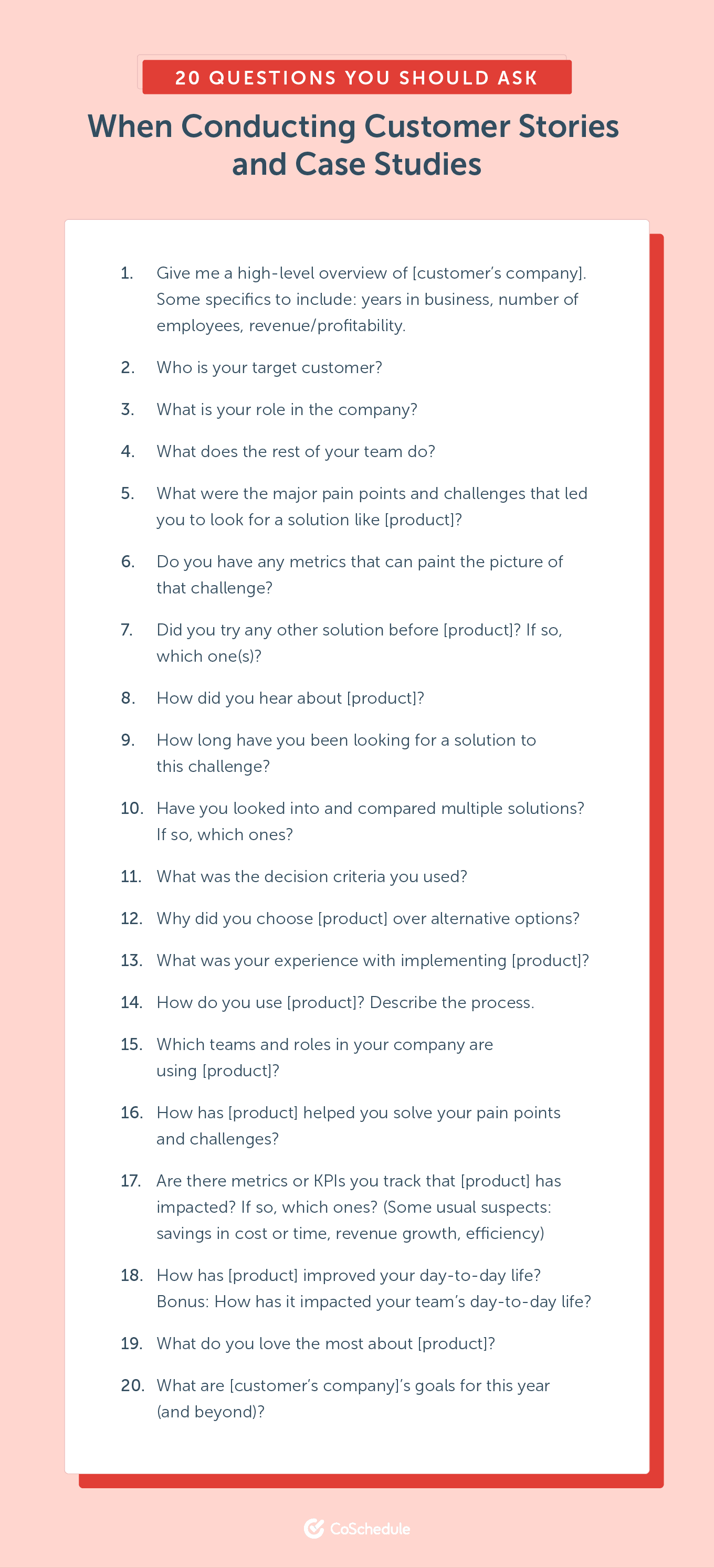
How to Turn That Information Into a Piece of Website Content
You’ve interviewed your customer. Now let's turn what you’ve learned into a powerful piece of content that will live on your website.Building Blocks of a Customer Success Story
Your customer success story needs the following parts:- A strong, click-enticing headline
- Company information: industry, company size, revenue, and other facts pertinent to your product
- Brief overview: an introductory paragraph that calls out most impressive outcomes and metrics
- The story itself: a narrative that includes your customer’s challenge, solution they’ve implemented, and the outcome they’ve experienced
 Your customer story can be as short as 200-300 words. Brevity will help you emphasize the true impact of your product — aim to keep your customer story under 500 words.
Your customer story can be as short as 200-300 words. Brevity will help you emphasize the true impact of your product — aim to keep your customer story under 500 words.
Aim to keep customer success stories under 500 words.
Click To TweetOptimize Each Part of Your Customer Success Story
Let’s dive into each of the building blocks so you can make them the best they can be.1. Headline
To make sure your customer success story gets opened by the right people, your headline must be up to scratch. Make sure your headline states:- Your customer’s company name, or another relevant identifier (for example, “a global fitness brand”)
- A compelling benefit or outcome
- Bonus: a data point
- Optional: your company name or product name
 You can see how each of these three examples uses different ways to talk about the customer, the results, and the product. Use it as inspiration!
Bonus tip: You can run your headline ideas through CoSchedule’s Headline Analyzer Studio for more tips and improvement ideas.
You can see how each of these three examples uses different ways to talk about the customer, the results, and the product. Use it as inspiration!
Bonus tip: You can run your headline ideas through CoSchedule’s Headline Analyzer Studio for more tips and improvement ideas.
2. Company Information and Setup
If your reader decided to read your customer success story thanks to its headline, this is the section that will convince them they’re in the right place. One piece of information per row works best, formatted for easy scanning. Check out CoSchedule’s Amp My Brand example: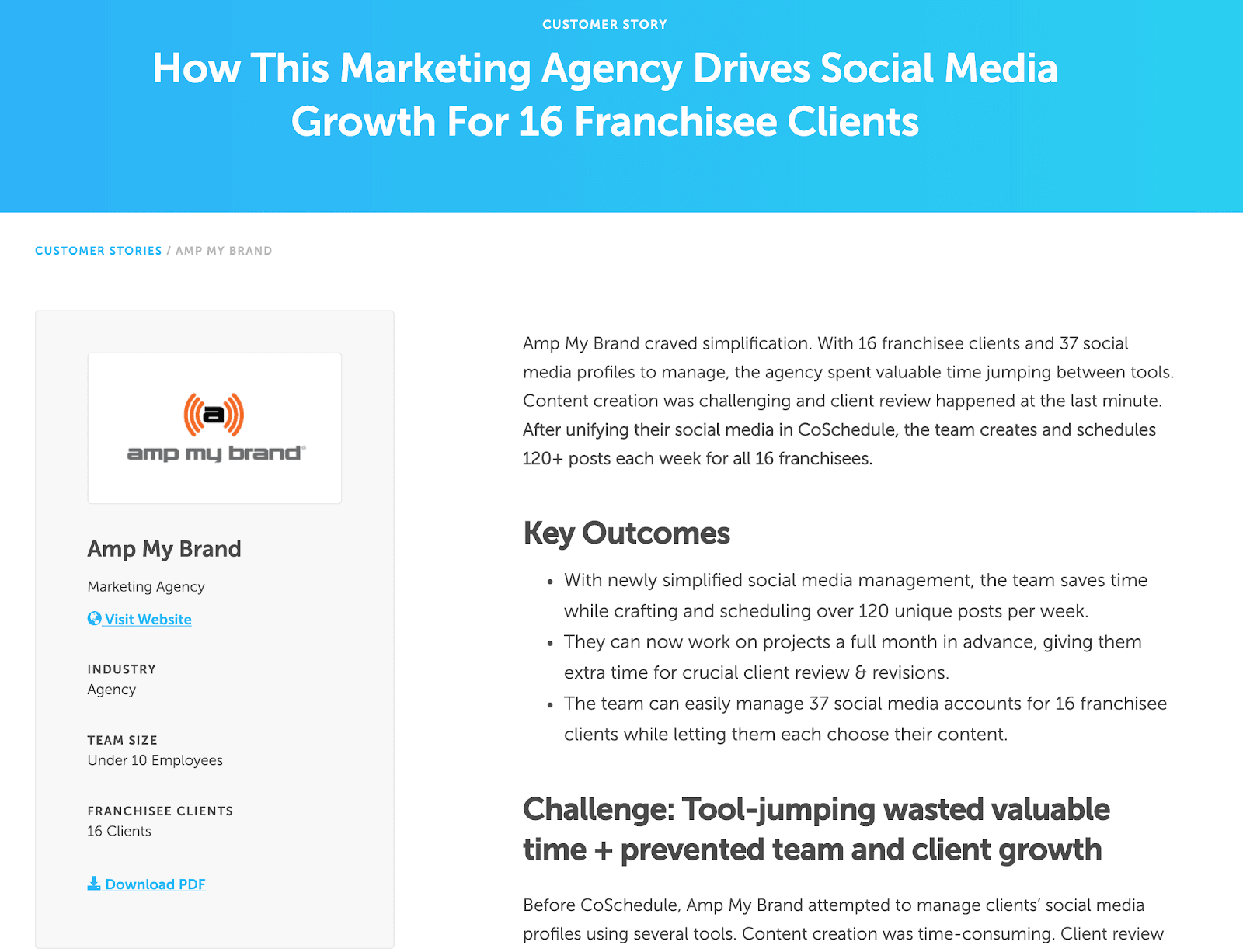 One thing’s for sure: if you’re a 5-person marketing agency with 10-20 franchisee clients, you’ll immediately be drawn to this story. That’s the idea behind this section.
One thing’s for sure: if you’re a 5-person marketing agency with 10-20 franchisee clients, you’ll immediately be drawn to this story. That’s the idea behind this section.
- Geographic location
- Revenue
- Job position of your interviewee
- Market share
- Their target audience
- Products/services used
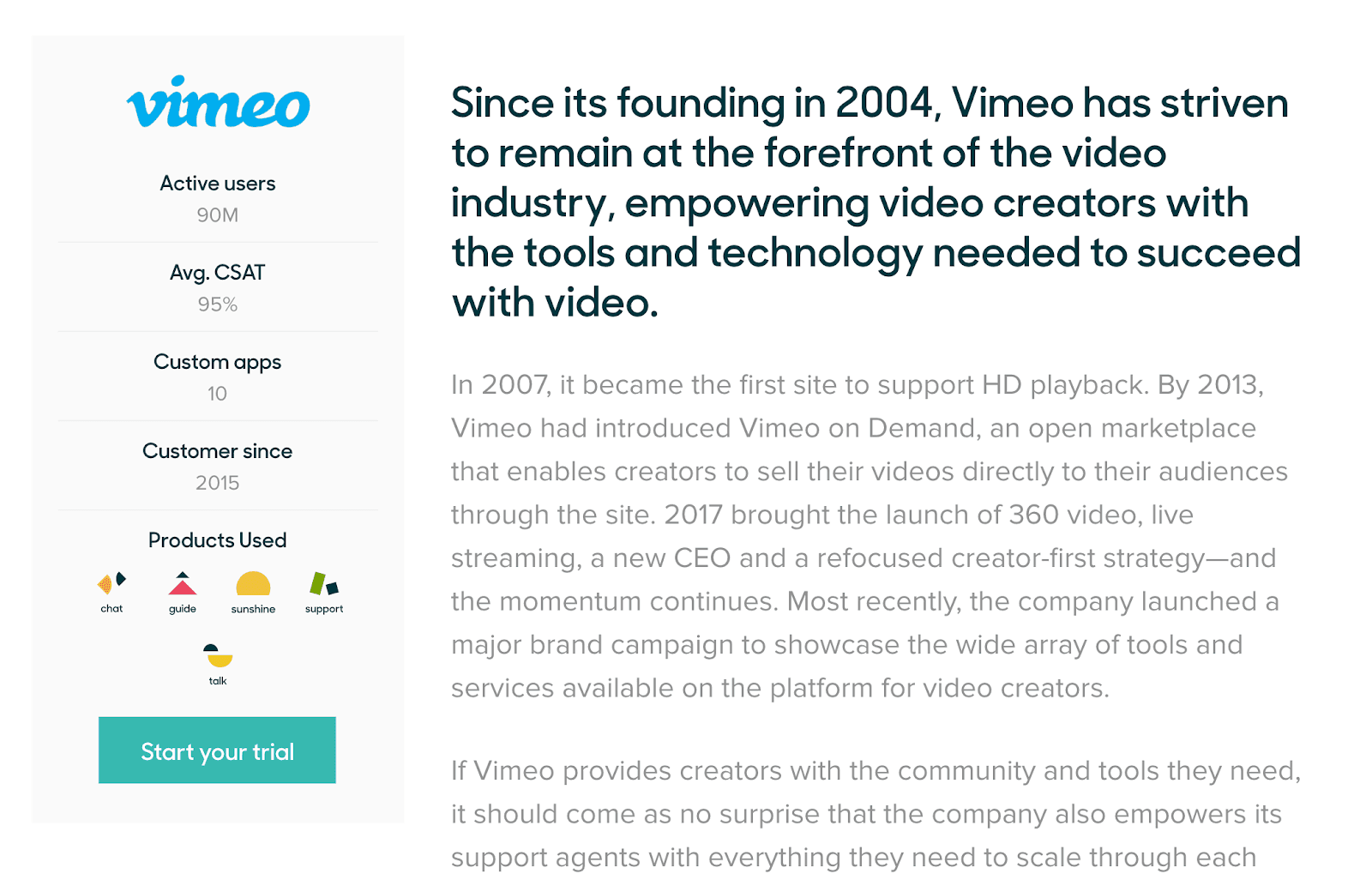
3. Introductory Paragraph (Overview)
Use this simple strategy to ensure your introductory section is appealing: inverted pyramid.Use the inverted pyramid as a simple writing strategy to ensure your introductory section is appealing.
Click To Tweet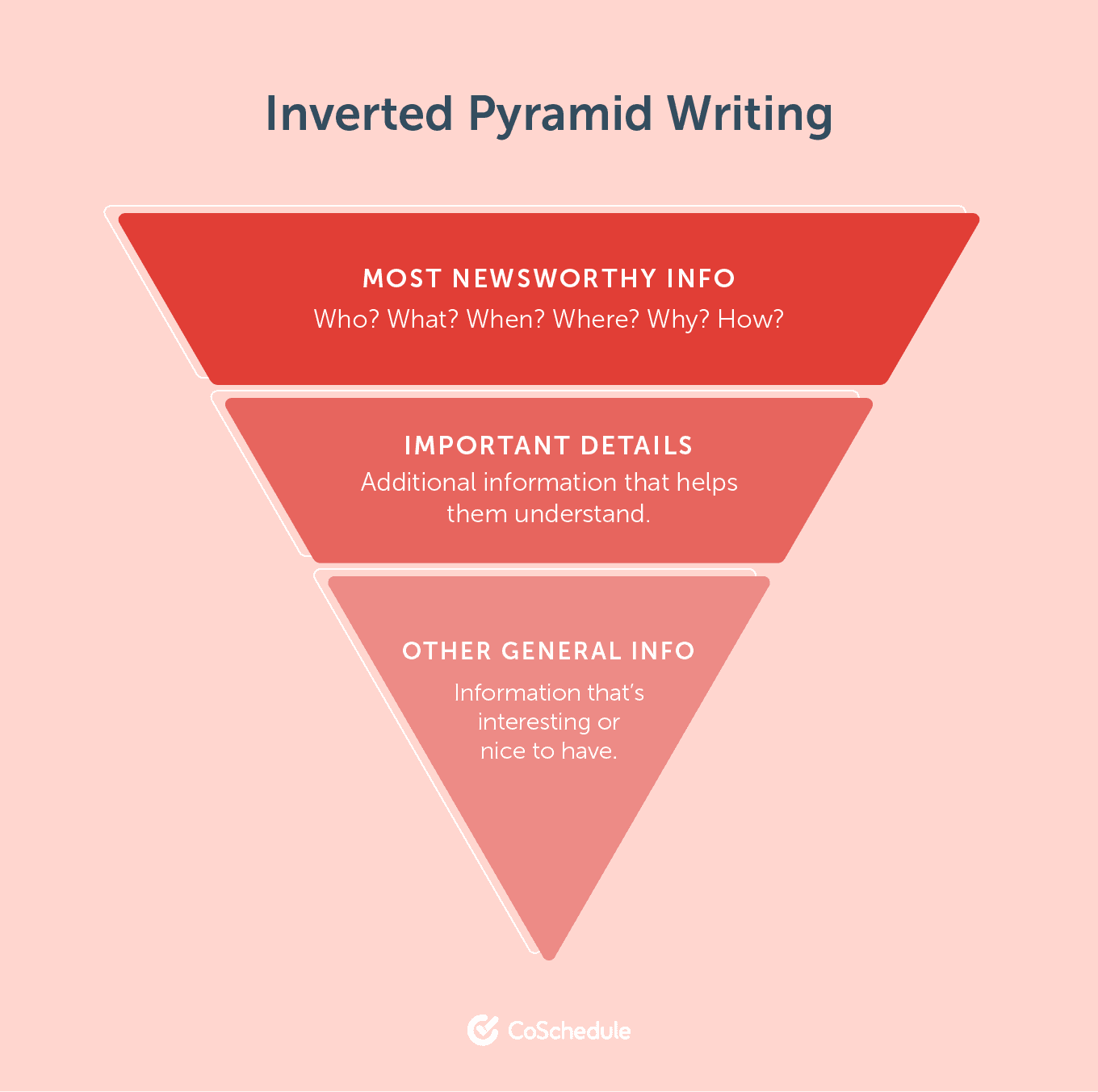 This part can be as short as 2-4 sentences. Here’s how CoSchedule’s Blue Medora customer story packs the most impactful information in a single, short paragraph:
This part can be as short as 2-4 sentences. Here’s how CoSchedule’s Blue Medora customer story packs the most impactful information in a single, short paragraph:
“Blue Medora has experienced incredible company growth of 80% year over year. But their 6-person marketing team struggled to adjust to that growth and complete an increasing number of projects on time. After a year of using CoSchedule, the team went from completing 5 projects to 66 projects on time per month. That’s 13x more projects delivered on time.”
4. The Narrative
All great stories have one thing in common: a well thought out structure. They take us through an obstacle that the protagonist is facing, and they end with a resolution. Image source
In customer success stories, that includes:
Image source
In customer success stories, that includes:
- The challenge
- The solution
- The results
5 Ideas to Share and Repurpose Your Customer Success Stories
Why would your customer success story stop at your website? By repurposing it on other channels, you’ll give each story the extra mileage. Here are some ideas.Send Your Customer Story to Your Email List
Your email newsletter is an ideal way to share a customer success story. Why? Because it delivers a personal story in a personal way.An email newsletter is an ideal way to share a customer success story because it delivers a personal story in a personal way.
Click To Tweet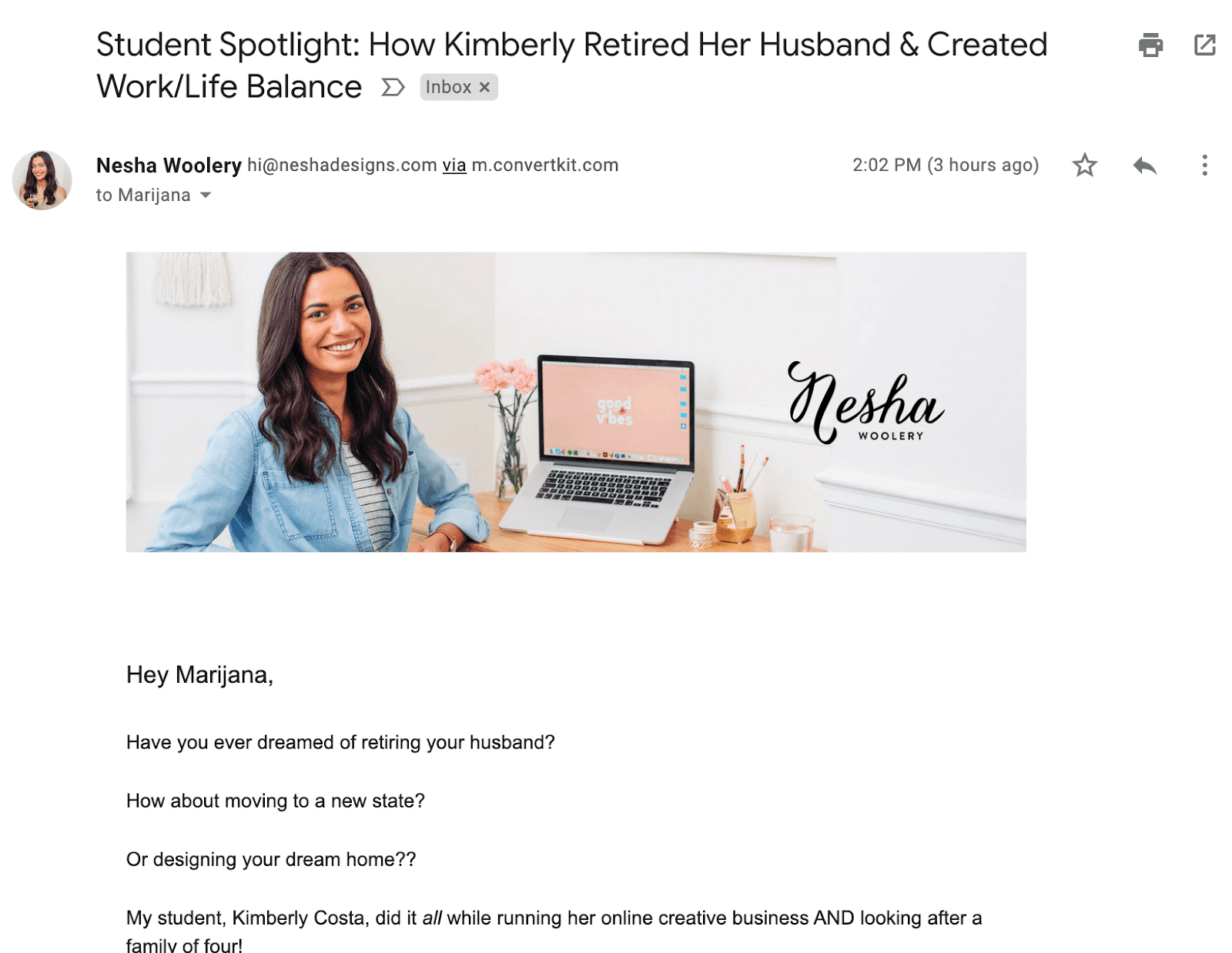
Turn Quotes and Visuals Into Social Media Graphics
Social media posts with images spark more engagement and shares than those without images. To make the most out of this, use the data you already have (your customer shared it with you!) and make it visual. You can create a simple graphic that quickly shows your customer’s results, like the one below, and share it along with relevant copy:

Add Customer Quotes to Press Releases
If you’re raising new funding, launching a new product, or opening new jobs, you’re likely reaching out to journalists. To appeal to them, same rules apply as with any other audience: they need proof and reassurance that what you’re saying has deserved their attention. So use your customer stories in your press releases to give it to them!Strengthen Your Ads With Testimonials
Use the main outcomes from your customer success stories as testimonials in your ad campaigns. According to Marketing Experiments, using a real person associated with your product instead of a stock photo increases conversion by 35%. Here’s a great example from Infolinks:
Turn Your Written Customer Success Story Into a Video
Video marketing and its benefits have been around for a while, so this is just a reminder: if you can, leverage video for your customer stories. Video will put a human face on it; it will help your potential customers resonate with a human being that experienced the challenges described in the written version of the story. A great example comes from a Marketing 360 story of Liftech (side note: pay attention to the first two sentences, which immediately paint a vivid picture of the challenge Liftech had to overcome):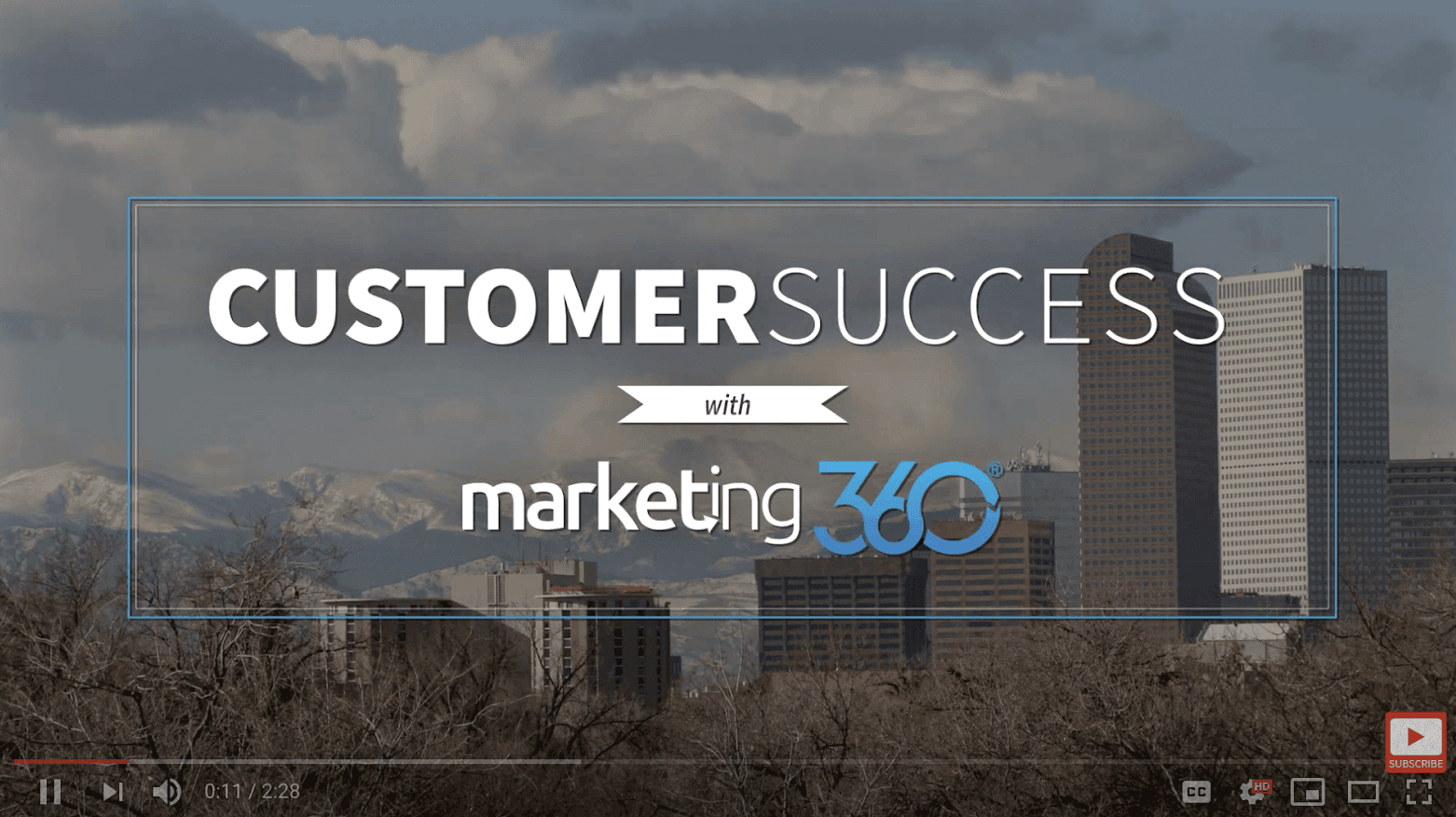
Your Customer Success Story Checklist
Want to start creating high-performing customer stories? Here’s a checklist for you to follow (and remember to grab our template for writing customer success story content!).- Identify happy customers
- Review CRM data
- Talk to your sales and support teams
- Identify power users
- Review product analytics
- Review ecommerce/sales reports
- Scan through your customer service tool (notes, chat logs, call transcripts, emails)
- Analyze data from your loyalty program software, project management system, or any other place that has data on customer behavior
- Email the customers you identified
- Set up your customer interview
- Review and tailor the list of 20 questions to your company, industry, and customer
- Decide which company information (e.g. industry, company size, revenue) needs to be prominent to your reader at the top of the story
- Create the company information section
- Build three parts of your customer story
- The challenge
- The solution
- The results
- Write the introductory paragraph (remember the inverted pyramid approach)
- Write a strong headline
- Publish your customer success story as a standalone piece of content on your website
- List other channels and formats for your customer story (e.g. email, social media graphics, ads, video)
Start Winning Your Ideal Customers With Success Stories
You know all the steps. You have all the tools — a template, customer questions, and a checklist — to start creating high-performing customer success stories. Don’t delay taking action. The sooner you start writing and publishing your customer success stories, the faster you’ll convert your website visitors into leads and customers.The sooner you start writing and publishing your customer success stories, the faster you'll convert your website visitors into leads and customers.
Click To TweetYou Know How To Utilize Customer Success Stories, What’s Next?
You have all the skills you need to use customer stories to your selling advantage, but you can always get better. Continue to learn, enroll in Actionable Marketing Institute's Public Relations Strategy Certification. This course gives students all the tools they need to create their own strategy to reach new audiences, boost credibility, and create growth based partnerships. Start learning crucial PR tactics.